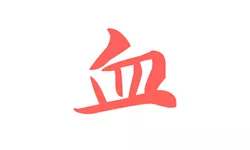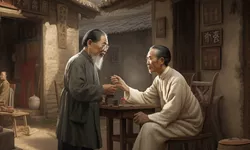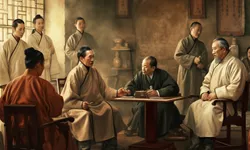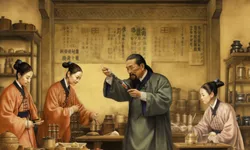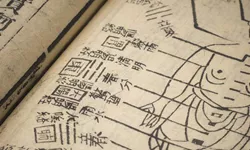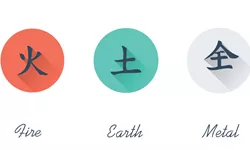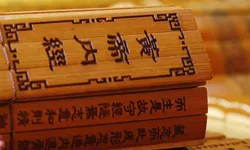The Yin-Yang theory is as old as China. It stems from the observation of nature: the perception that nothing exists without its opposite. Heaven and earth, sun and moon, day and night, cold and heat, men and women, up and down, etc. As early as the Spring and Autumn Period (771 to 476 BC ), some of the most important Chinese philosophers such as Laozi already mentioned Yin and Yang. The Yin-Yang theory has penetrated into all aspects of traditional Chinese culture, including religion, philosophy, the Chinese calendar, Chinese medicine, calligraphy, or architecture.
In Traditional Chinese Medicine specifically, Yin-Yang theory is fundamental. Chinese doctors base themselves on the theory to explain how the body works, how diseases invade it and to guide clinical diagnosis and treatment. It has become one of the basic theories in Chinese Medicine.
The initial meaning of Yin and Yang is very simple. It refers to both sides of a hill illuminated by the sun: the sunny side is Yang (陽) and the side under the shadow is Yin (陰). The ancient Chinese philosophers then applied the term to describe what they'd realized was a basic law of the universe.
Yin-Yang: the general concept

Dongtian Mountain Hall, attributed to Dong Yuan (10th century AD). Chinese art often attempts to achieve the ideas of balance, harmony and change contained in the Yin-Yang theory
The Yin-Yang theory holds that everything in the natural world includes two aspects of Yin and Yang that are at the same time mutually antagonistic and unified. For instance what would joy mean without sadness? Or cold without heat? They're antagonistic concepts but they cannot exist without each others. The Yin-Yang theory holds that the opposite movement of Yin and Yang is the root cause of the occurrence, development, change, and demise of everything in nature. The Huangdi Neijing, often considered as the Bible of Chinese Medicine, says: "Yin and Yang, the way of heaven and earth, is the discipline of all things, the parents of change, the origin of life and death." Therefore, the contradiction between Yin and Yang, the law of unity of opposites is the inherent law of everything in the natural world and the world itself is the result of Yin and Yang together.
Ancient Chinese doctors have widely applied the Yin-Yang theory to the medical field to illustrate the origin of human life, physiological phenomena, pathological changes, and to guide clinical diagnosis and prevention. The theory play a very profound role in the formation and development of the theoretical system of traditional Chinese medicine.
Yin-Yang when applied to Chinese medicine
The theory is widely used to analyze the many complementary opposites that exist within the human body. In general, all things that are in movement, have an outward or up direction, are warm or bright are all Yang. On the other hand things that are relatively still, have an inward or down direction, are cold or dark are all Yin. For instance Water and Fire are seen as complementary and respectively Yin (because Water is cold and humid) and Yang (because Fire is hot and dry). The Yin-Yang appellation doesn't apply to everything: it must be applied to a pair of things that are related to each other. If the two things being analyzed are not related to each other, or are not two opposite aspects of the same element, one cannot use Yin and Yang to describe their mutual relations.
The Yin and Yang attributes are not absolute but relative. Again a concept like sadness has no meaning without joy. It only exists thanks to the existence of its opposite concept. This relativity means that under certain conditions, Yin and Yang can be transformed into each other. That is, Yin can be transformed into Yang, and vice versa. If we were to continue with the example of sadness and joy, let's imagine someone who only ever experiences joy. That person will describe milder joy as sadness because it feels sadder than extreme joy. Joy therefore becomes sadness.

Yin-Yang drawing in a temple in Quanzhou, Fujian province
Yin and Yang are mutually inductive to each others, which means that it is the very interaction between Yin and Yang that creates each others. Ancient Chinese philosophers believed that all things originate from this interaction between Yin and Yang. For example, the Book of Rites says: “The heavens and the earth and all things are born as the Yin and Yang are changed.” The Yang of heaven falls, the Yin of the earth rises, and the Yin and Yang mutually induce each other, producing all things and forming rain, fog, lightning, rain, sunshine, or air. If there is was no mutually inducing movement of Yin and Yang, there would be no natural world and no life. Mutually inducing Yin and Yang is the basic condition of life.
The interaction between Yin and Yang is not immutable, there's a constant struggle to reach an equilibrium between both. For example in Chinese medicine daytime is Yang: physiological function are all running at full capacity. Nighttime, on the other hand, is Yin: the body is resting. From midnight to noon, Yang is believed to gradually swell and the body's physiological functions progressively turn from rest to excitement. In other words Yang is gradually gaining in importance over Yin. From midday to midnight, Yang gradually declines, and the body's physiological functions change from excitement to inhibition. Yin takes over.
The organisation of the body from a Yin-Yang perspective
The Yin-Yang theory states that the human body is an organic whole, filled with the unity of Yin and Yang. The upper part of the body is Yang and the lower part is Yin; the body surface is Yang and the inside of the body is Yin; the back is Yang and the front is Yin; the outer limbs are Yang, and the insides of the limbs are Yin. In terms of organs, the Zang organs (Heart, Liver, Spleen, Lungs, and Kidneys) are Yin because their functions are mainly static; the Fu organs (gall bladder, stomach, small intestine, large intestine, urinary bladder, triple burner) are Yang, because of their function are seen as dynamic. The meridians can also be divided into Yin and Yang.
Chinese medicine believes that the various activities of the human body are the result of the coordinated relationship between Yin and Yang that maintains unity of opposites. The body is made of substances that at the same time it create these very substances. If the Yin and Yang of the body cannot be interdependent and use each other, human life will cease.
Yin and Yang as an explanation for diseases
Chinese medicine believes that the occurrence of diseases is caused by the imbalance between Yin and Yang. These can be collectively referred to as "Yin and Yang disharmony". They can be generalized in the following four categories: Yin or Yang surplus, Yin or Yang deficiencies, Yin and Yang depletion, and Yin and Yang conversion.
Yin or Yang surplus refers to higher than normal Yin or Yang caused by an external pathogen or their own pathological hyperactivity. A Yang surplus could for instance result in symptoms of a very dry mouth and fever since Yang brings heat to the body.
Yin or Yang deficiencies refers to Yin or Yang levels below normal. A sign of a Yang deficiency, since Yang is heat, could for instance the feeling of being constantly cold.
Yin and Yang depletion refers to cases where both Yin and Yang are deficient and the fundamental relationship between both is broken.
Yin and Yang conversion refers to phenomenons where Yin and Yang are transformed into each other.
Diagnosis and treatment of diseases within the Yin-Yang theory
Since Traditional Chinese Medicine believes that the cause of diseases is Yin-Yang disorders, any disease, no matter how complex or varied its condition, can be diagnosed using the Yin-Yang theory. A Chinese doctor's first goal always is to diagnose a patient's current balance of Yin and Yang. In determining appropriate treatments, Chinese medicine is also guided by Yin-Yang theory. For example, for a patient suffering from excessive heat due to a Yin deficiency, a Chinese doctor will prescribe Yin medicine to make up for deficiency. Or in the case of a Yin and Yang depletion, it is necessary to make up for both Yin and Yang. The Yin and Yang theory can also be used to summarize the taste of traditional Chinese medicine and to guide clinical use. In general cold medicine is Yin while hot medicine is Yang. What tastes acid, bitter, salty is Yin while ingredients that are spicy and sweet are Yang. The principles of a treatment are determined according to the Yin and Yang nature of the disease, and medications are determined based on the Yin and Yang attributes of the drugs.
Yin-Yang from a modern medicinal standpoint
Is there any scientific basis to the Yin-Yang theory? Scientific are progressively realizing that the concept is not too detached from physiological reality.
For instance Professor Earl Sutherland described the antagonistic actions of cAMP and cGMP in regulating cellular function in a fashion similar to the Yin-Yang concept, and this earned him a Nobel Prize in Physiology or Medicine in 1971.
Similarly in neuroscience, the Yin-Yang phenomenon is exemplified by the long-known antagonizing relationship between parasympathetic and sympathetic neural activities in the body. A recent psycho-physiological investigation in human subjects has revealed an association of decreased parasympathetic and sympathetic activities with deficiencies of Yin and Yang, respectively, in the body.
Lastly the laboratory of Professor Robert Ko at the Hong Kong University of Science & Technology has investigated the opposing relationship between antioxidation and oxidation in the cell. They've found out that in a healthy cell, Yin and Yang activities are in balance. However when Yang activities are higher than those of Yin, cellular oxidative stress is increased. Furthermore they've proven that Yang-tonifying herbs can activate energy metabolism and increase ATP production in the cell, whereas Yin tonifying herbs can produce an immuno-modulatory action. Their conclusion is that the actions produced by Chinese Medicine herbs can help preserve mitochondrial structural and functional integrity and maintain immune competence in the body, thereby retarding the aging process.
Sources:
Ted J. Kaptchuk (1983). The Web That Has No Weaver: Understanding Chinese Medicine. Chicago, Il., U.S.A.: Congdon & Weed.
Ko, Robert. Health Concepts in Chinese Medicine [PDF documents and videos]. Retrieved from The Hong Kong University of Science and Technology on Coursera: https://www.coursera.org/learn/health-concepts-chinese-medicine
Yin and Yang. (n.d.). In Wikipedia. Retrieved April 17, 2018, from https://en.wikipedia.org/wiki/Yin_and_yang
阴阳. (n.d.). In A+医学百科. Retrieved April 17, 2018, from http://www.a-hospital.com/w/%E9%98%B4%E9%98%B3
The yin and yang of cardiac autonomic control: vagosympathetic interactions revisited. Paton JF, Boscan P, Pickering AE, Nalivaiko E. Brain Res Brain Res Rev 2005;49:555–565.
The application of yin-yang concept on heart rate variability patterns in menopausal women with insomnia. Yen-ying Kung (龔彥穎), Cheryl C. H. Yang (楊靜修), Jen-hwey Chiu (邱仁輝), Terry B. J. Kuo (郭博昭). Chin J Integr Med. 2016 Jun 29.
Article tags: Chinese Medicine theory

